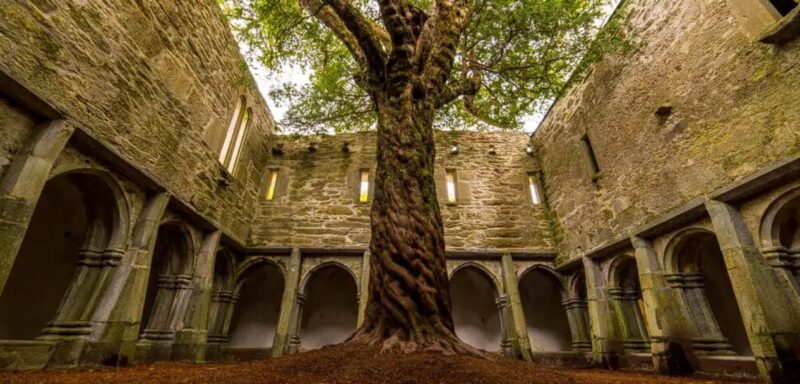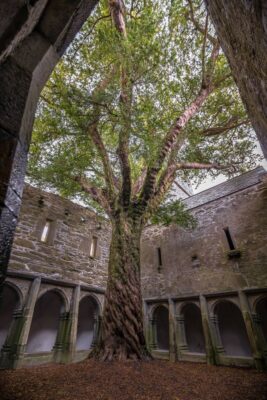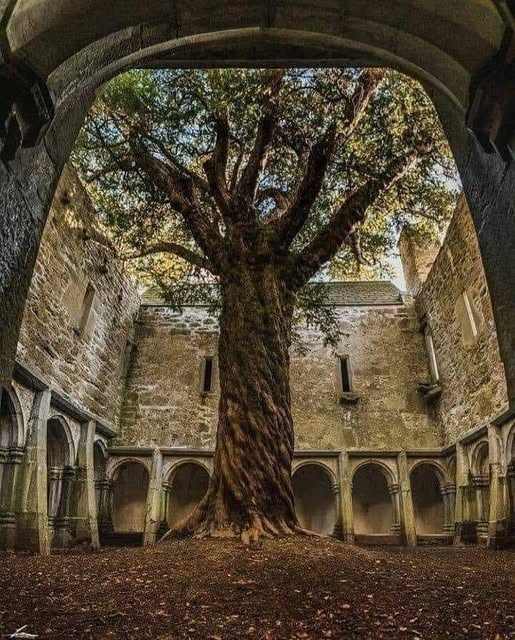The 400-year-old yew tree at Muckross Abbey, Ireland, is a remarkable symbol of both nature and history. This ancient tree, nestled in the heart of the Muckross Abbey grounds, has witnessed centuries of change and continues to stand as a living testament to the enduring beauty of Ireland’s natural heritage. With its deep historical significance and awe-inspiring presence, the yew tree is one of the most iconic features of Muckross Abbey. In this article, we explore the history, significance, and enduring beauty of this remarkable yew tree. Follow archeology.dulichvn.net to discover many hidden mysteries that have yet to be discovered.

The History of Yew Tree at Muckross Abbey
Origins of Muckross Abbey
Muckross Abbey, built in the 15th century, is located in County Kerry, Ireland, and has a rich history that intertwines with the surrounding landscape. Originally founded as a Franciscan friary, the abbey served as a place of religious worship and community. Over the centuries, it faced numerous challenges, including attacks during the Cromwellian wars, but parts of the abbey have remained intact, attracting both historians and visitors. The yew tree, estimated to be over 400 years old, has stood within the abbey’s walls, growing alongside this ancient religious site, creating a unique connection between nature and history.
Significance of the Yew Tree
The 400-year-old yew tree at Muckross Abbey is one of the oldest and most notable trees in Ireland. Yew trees have long been associated with spirituality and longevity, often found in the grounds of ancient churches and monasteries. The tree’s placement within the abbey’s grounds suggests that it has been there for much of the abbey’s history, standing as a silent witness to the centuries of activity, worship, and change around it. The yew tree’s age and presence at this historical site have made it an integral part of the cultural heritage of Muckross Abbey.
A Symbol of Resilience
The yew tree’s ability to thrive for over 400 years speaks to its resilience. Throughout its long life, the tree has weathered harsh Irish winters, storms, and the passage of time. Yew trees are known for their longevity and ability to regenerate from their roots, which adds to their symbolic meaning as a representation of endurance and survival. In the case of Muckross Abbey, the tree stands as a symbol of the enduring spirit of both nature and the community that has cared for it throughout the centuries.

The Ecological and Aesthetic Importance of the Yew Tree
Ecological Role in the Muckross Estate
The 400-year-old yew tree is more than just an ancient relic; it plays a vital role in the local ecosystem. Yew trees are known for their ability to support a variety of wildlife, providing shelter and food for birds, insects, and other creatures. Its location in the Muckross Abbey grounds means that it contributes to the biodiversity of the surrounding area, adding to the overall ecological value of the Muckross Estate, which is a designated national park. The yew tree’s presence in this natural environment emphasizes the importance of preserving such ancient living monuments.
Aesthetic Appeal and Visitor Attraction
The 400-year-old yew tree at Muckross Abbey is also a major aesthetic feature of the site. With its gnarled and twisting branches, the tree provides a picturesque and serene setting for visitors. The combination of the ancient abbey ruins, the surrounding gardens, and the yew tree creates a tranquil atmosphere, making it a popular destination for tourists and photographers alike. Its majestic presence adds to the spiritual and visual beauty of Muckross Abbey, making it a must-see for anyone visiting County Kerry.
Inspiration for Artists and Poets
The striking appearance and long history of the yew tree have inspired countless artists, photographers, and poets over the years. Its timeless beauty and deep-rooted connection to Ireland’s past have captured the imaginations of many who visit the site. For centuries, yew trees have been symbols of wisdom, strength, and mystery, often serving as muses for creative works. The Muckross yew tree is no exception, drawing attention for its intricate structure and the stories it may hold within its ancient bark.

Protecting the 400-Year-Old Yew Tree for Future Generations
Conservation Efforts at Muckross Abbey
Preserving the 400-year-old yew tree and the surrounding area is of paramount importance. Efforts are continuously made to protect the tree from environmental threats, disease, and damage caused by human activity. The National Parks and Wildlife Service, along with local conservation groups, monitor the health of the tree and work to maintain the surrounding landscape to ensure that this ancient living monument continues to thrive for generations to come. Proper conservation ensures that the tree remains an integral part of Muckross Abbey’s historic and natural heritage.
Balancing Tourism and Preservation
While the yew tree is a significant tourist attraction, there is a balance to be struck between attracting visitors and preserving its delicate ecosystem. Tourism management is essential to ensure that visitors can appreciate the tree’s beauty without damaging it or disturbing its natural environment. Educational programs and guidelines are in place to inform tourists about the importance of the yew tree and the need for its protection. This ensures that future generations can continue to experience its magnificence.
The Role of Local Communities in Conservation
The preservation of the yew tree is not only the responsibility of government agencies but also of the local community. Many residents of County Kerry view the Muckross Abbey yew tree as a cherished part of their heritage and take pride in its preservation. Local volunteers and conservationists actively participate in protecting the tree and its surroundings, ensuring that this living piece of history is maintained for the enjoyment and education of future generations.
See more: The Lovers of Valdaro: A 6,000-Year-Old Testament to Ancient Love
Conclusion
The 400-year-old yew tree at Muckross Abbey is a remarkable natural and historical monument that embodies the spirit of Ireland’s rich cultural and ecological heritage. Standing tall amid the ruins of the abbey, the tree has witnessed centuries of change and continues to inspire awe and admiration. Its deep connection to the abbey, the local community, and the environment makes it an irreplaceable part of Ireland’s national history. Through ongoing conservation efforts and a commitment to preserving this ancient tree, Muckross Abbey will continue to share its story with visitors from around the world for generations to come.


CÁC TIN KHÁC
Mary Walton: The Forgotten Inventor Who Helped Clean Up America’s Cities
Tomb of Queen Nefertari in the Valley of the Queens, Egypt
Discover the Hypostyle Hall of the Temple of Hathor at Dendera
Venus de Losange: Unveiling the Mystery of a 20,000-Year-Old Paleolithic Icon